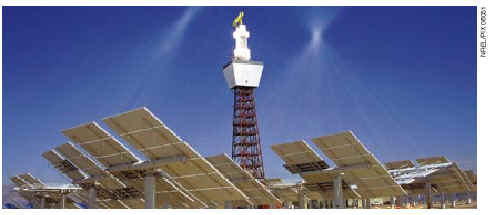
Solar Power Towers
These systems produce electricity on a large scale. They are unique among solar
technologies because they can store energy efficiently and cost effectively. They can operate whenever the customer needs power, even after dark or during cloudy weather.
During daylight hours, 2000 mirrors at Solar Two track the sun and store its energy as heat in
molten salt. This energy can then be used to generate electricity when needed, such as during periods of peak demand for power.
The high desert near Barstow, California,
has witnessed the development of this country's first two solar power towers. Solar One operated successfully from 1982 to 1988 and proved that power towers work efficiently to produce utility-scale power from sunlight.Solar Two was connected to the utility grid in1996 and is operating today. Like its predecessor, Solar Two is rated at 10 megawatts. An
upgrade of the Solar One plant, Solar Two demonstrates how solar energy can be stored in the form of heat in molten salt for power generation on demand.The experience gained with these two pilot
power towers has established a foundation on which industry can develop its first commercial plants.Advancing Technology
Power towers operate by focusing a field
of thousands of mirrors onto a receiver located at the top of a centrally located tower. The receiver collects the sun's heat in a heat-transfer fluid, which is used to generate steam for a conventional steam turbine located at the foot of the tower for production of electricity.Based on their experience with Solar One,
which used water/steam as the heat-transfer fluid, SunuLab engineers determined that power towers would operate more efficiently using molten salt. The salt would have the further advantage of providing a practical way to store the heat.The concept of storing energy in molten salt
and decoupling solar energy collection from electricity production are in fact the bases for Solar Two (see diagram on back page). During operation, the salt is heated to more than 565¡C (1050¡F) and stored in a tank next to the tower. When electricity production is needed, the hot salt is pumped from this "hot" storage tank to the steam generator.The power tower system with energy storage has one unique advantage over other solar
power systems: Solar Two produces power when the local utility, Southern California Edison Company, needs it most--during peak periods. These periods occur on hot, sunny afternoons and into the evenings during the air-conditioning season when power production is most valuable to the power company.Power towers also have distinct advantages over conventional power plants. Like all solar technologies, they
consume no fuel, so they do not pollute the environment. Similarly, they are capital intensive but cost little to operate. Land use for power towers is about on par with that of conventional power-generating technologies using fossil fuels.For on-line information about the U.S. Department of
Energy's Concentrating Solar Power Program, please visit its web site: http://www.eren.doe.gov/sunlabConcentrating
Solar Power
Program
Concentrating
Solar Power
Program